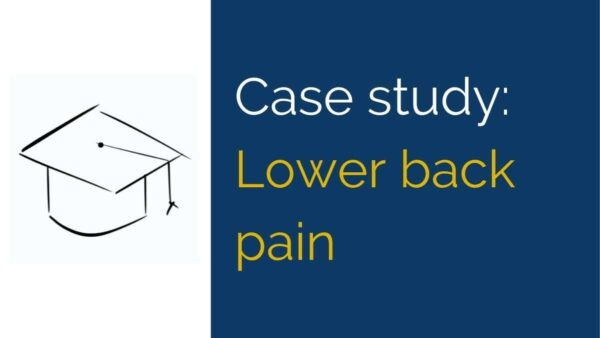Background
Lower back pain can present diagnostic difficulties without a clear structural diagnosis. Use this case to develop a functional (rather than structural) approach to assessment and management with each action justified by linking it to a specific aspect of the case.
Minimum Level
New Graduate Physiotherapist and Physiotherapy student
History
Jenny is a 34 year old new Mother with a 2 month old baby girl. She presents with lower back pain (LBP) associated with prolonged sitting and picking up her baby from ground level.
What additional questions do you need to ask that are specific to a new mother?
Mentor’s reasoning:
The lower back pain commenced 3 weeks after giving birth without any obvious incident or change in habit.
Discuss the timing of pain onset and how it might impact on your reasoning regarding the cause of Jenny’s pain.
Mentor’s reasoning:
During pregnancy, Jenny had significant Left anterior hip and central anterior pelvic pain. The pelvic pain resolved soon after delivery but the anterior hip pain has only partially eased.
Do you think the hip and pelvic pain Jenny experienced during pregnancy is related to the current lower back pain? Explain.
Mentor’s reasoning:
Jenny has tried some morning yoga stretches and paracetamol without any noticeable improvement in her lower back pain.
Does the lack of improvement with yoga stretches and paracetamol affect your planned management strategy?
Mentor’s reasoning:
There are no symptoms referring into the legs and no paraesthesia noted.
Can we rule out nerve root compromise based on the lack of neurological symptoms?
Mentor’s reasoning:
Jenny feels that her pain is there continuously throughout the day but with varied intensity. She finds her back is uncomfortable early in the morning with lower back pain intensity varying throughout the day based on the position she’s in.
Are you concerned about red flags due to the constant nature of Jenny’s pain? Explain your rationale.
Mentor’s reasoning:
Prior to having her baby, Jenny had an active lifestyle with regular gym sessions and daily walking.
Discuss how this may affect your planned management strategy.
Mentor’s reasoning:
What further questions would you ask Jenny regarding her LBP?
Mentor’s reasoning:
Objective Examination
On examination, Jenny has good range in all directions with only mildly increased pain with end range extension.
Is this finding what you would expect based on your history?
Mentor’s reasoning:
Does this impact your diagnostic reasoning in any way?
Mentor’s reasoning:
On palpation, Jenny has some localised tenderness on Left L3-5 unilateral mobilisations.
Explain the physiological effect that mobilisations have on the spine.
Mentor’s reasoning:
Her Straight Leg Raise (SLR) test produces significant hamstrings tightness at 40 degrees. Adding dorsiflexion moves the tightness distally to behind the knee. This result is symmetrical between sides.
Is this SLR test positive? Detail the requirements for a positive finding.
Mentor’s reasoning:
Will this test have any bearing on your planned management strategy?
Mentor’s reasoning:
What further tests would you conduct in your objective examination?
Mentor’s reasoning:
Management plan
Based on the above information, provide three key approaches that you believe will be effective for Jenny’s lower back pain.
Link each of these approaches to an aspect of the history or examination that provide the basis for their inclusion.
Mentor’s reasoning:
How will you re-evaluate the progress of Jenny’s lower back pain? When would you re-evaluate?
Mentor’s reasoning:
Like to continue the conversation? Head over to our Facebook page.

